
Vulnerable children in care were “stripped of their dignity” and lived in environments where violence was “endemic”, an inquiry has been told.
A group representing survivors of in-care abuse said children with long-term needs “had no opportunity to flourish and fulfil their potential” in several Scottish institutions.
The Scottish Child Abuse Inquiry heard closing submissions related to its current phase, which examined 17 residential establishments for children with long-term disabilities and additional support needs.
These included Lennox Castle in Glasgow, Donaldson’s School for Deaf Children in Edinburgh, St Vincent’s School for the Deaf and Blind in Edinburgh and Melville House in Fife.
Simon Collins represented In Care Abuse Survivors (INCAS) at the inquiry as he delivered its closing submission on Friday.
He emphasised the “particular vulnerability” of the children in these institutions, many of whom struggled with communication.
He said: “But those factors do not excuse the reality that, once again, the inquiry has heard that children often had nowhere to turn when something happened to them.
“Where they did raise an issue, it was rare for them to be believed and for something to be done.”
He noted that corporal punishment was routinely used in some of the institutions, with little regard for the children’s education.
Deaf children were punished for using sign language with their peers, he said.
Mr Collins said: “The picture presented in this case study, across all the institutions investigated, is one of children being stripped of their dignity, of being routinely humiliated, living in environments where casual violence was endemic.
“Where they were not protected from abusive staff or from abuse by their peers.
“They had no opportunity to flourish and fulfil their potential – they were not thought to have any potential.”
Phase 9 of Lady Smith’s inquiry heard from 133 witnesses across 43 days. More than 11,000 documents were gathered.
Ruth Innes KC, senior counsel to the inquiry, said: “The inquiry has heard evidence that children and young people suffered physical and sexual abuse.
“There was also serious emotional abuse and neglect, some children and young people were not afforded any dignity or humanity.
“Children and young people were placed in institutions for the purposes of containment or control of what was viewed as ‘challenging behaviour’.
“The regimes to which they were then subjected reflected that view. Abusive staff behaviour was, on occasion, mirrored by children.
“Corporal punishment was deployed contrary to government guidance, policy and legislation.”
